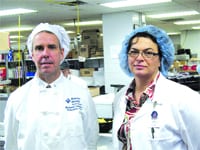Food as Fuel Hospitals Are Taking a Closer Look at What Patients Are Eating
The fold-out menu — professionally designed, peppered with attractive graphics, and printed on heavy stock — wouldn’t be out of place at an Applebee’s.
The dozens of menu selections range from shrimp provencal to marinated sirloin steak to pesto and artichoke pizza — all of it made to order, when the customer feels like having a bite.
Welcome to … Baystate Medical Center. Really.
“One of the best predictors of how well a patient is going to recover is how well they eat, because obviously, food is fuel, and the more fuel you take in, the stronger you’re likely to be, and you’ll get better faster,” said Kathy Egan, Baystate’s patient services manager. “One study of traditional hospital service showed that a full 25{06cf2b9696b159f874511d23dbc893eb1ac83014175ed30550cfff22781411e5} of meals are going to waste because they’re delivered when the patient isn’t in the room or otherwise not available.”
Statistics like that were the basis of Baystate’s new room-service system, in which patients order off an extensive menu when they want to eat, and the meal is delivered within 45 minutes. So late sleepers can still have breakfast, and a consultation with a doctor or a family visit won’t cause anyone to skip dinner.
On-demand room service is certainly an uncommon way to improve the way patients eat, but it’s far from the only way hospitals are improving nutrition and dietary habits for patients, employees, and visitors alike.
“In terms of healthy eating, we’re of course looking at the food we provide to patients, but also the cafeteria food staff members and visitors eat, and also vending machines,” said Young Hee Kim, clinical nutrition manager at Mercy Medical Center. “We’re trying to utilize more fresh fruits and vegetables in our cooking, and we’ve moved away from higher-fat ingredients and substituting those with low-fat items.”
It’s a trend that many regional hospitals have embraced, and in farm-friendly Western Mass., it also often includes an emphasis on using locally raised products, which are fresher than store-bought items.
As Egan said, it’s all about fuel — making sure the body gets enough, and the right kind.
Bedside Service
Baystate’s room service is nothing short of a values shift.
“What hospitals have done traditionally is what is expeditious for the medical staff,” Egan said. “If meals are delivered at a set time on a certain floor, with breakfast coming right at 7:15, and lunch and dinner also coming at the same time every day, that’s great for the medical staff because they can plan their whole day around the patient’s schedule. But it doesn’t always work well for the patient.”
In addition, she said, meal selection was limited, with items designed to be cooked in bulk and shipped to the floors — and often wasn’t very appetizing. “Now we serve a family-style Mediterranean diet, and assume that patients are awake, alert, and well enough to eat when they order.”
“When we changed over to room service, we changed the entire system to restaurant style,” said Richard Callahan, executive chef, as he took The Healthcare News on a tour of the kitchen area, where meal orders are printed out, assembled by line cooks, and loaded on carts for quick delivery within 10 minutes of plating. “This kitchen looks like you walked onto an Applebee’s or Chili’s line, and we continue to focus heavily on Mediterranean-style cuisine using local, fresh produce.”
Baystate is one of several hospitals involved with Community Involved in Sustaining Agriculture (CISA), an organization that promotes the buying of local farm produce. “We got away from a lot of frozen vegetables that you traditionally see in hospitals, we’re using whole-wheat rolls instead of white rolls, and we’re making pizzas with fresh mozzarella and tomatoes.”
“We’ve made changes for the better, and we’re always trying to encourage more ecologically sound eating,” Kim said of Mercy’s nutritional efforts. “For example, we have a farmers’ market available at Mercy throughout the summer for the staff to take advantage of, and eventually we’ll be able to incorporate more local produce into our patient menus. It’s fresher, more nutrient-dense, and supports the local economy and local farmers.”
Three years ago, Cooley Dickinson Hospital in Northampton became the first hospital to sign onto CISA’s ‘Be a Local Hero, Buy Locally Grown’ initiative. Earlier this year, it followed that effort up by signing the Healthy Food in Healthcare Pledge, a program of national organization Health Care Without Harm that encourages hospitals to serve healthier, more environmentally friendly (often meaning locally grown, without too many travel miles between field and plate) food.
Health Care Without Harm suggests there is a growing recognition that the way food is produced and distributed is often misaligned with dietary guidelines, and reports that hospitals that have signed the pledge have eliminated deep fryers, established farmers’ markets, and replacing processed foods with items purchased from local growers.
“We have started by taking small steps,” said Daniel English, director of Food and Nutrition Services at Cooley Dickinson. “We see the pledge as a foundation for increasing our efforts around health and sustainability.”
Lessons for Later
When it comes to patient diets, hospitals have to follow strict guidelines for certain diners — for instance, diabetics and those with heart conditions. Baystate actually offers separate menus for such patients, but because the food choices are prepared in a healthful manner, many are common to all the menus, Callahan said.
“We still have to walk a line between providing food for sick patients and healthier patients,” Egan said, “but we always make a point of offering healthy choices.” The hope, beyond keeping patients well-fueled in the hospital, is that such meals will become teaching moments that people can apply to their diets when they return home.
Kim said patients still want food that tastes good, so chefs must be creative with flavors. If a soup has a reduced cream content these days, a lot of herbs and vegetables might be used to provide just as much flavor in a healthier way. Likewise, Mercy is looking for a vendor to stock its vending machines with fresh salads and sandwiches, so even people grabbing a bite on the run can have healthy options.
“Healthy eating in the health care setting has become a huge push nationally,” she said. “We’re keeping pace with this trend and promoting healthy eating here in the hospital.”
And, just maybe, helping people develop habits that will keep them from returning.




Comments are closed.